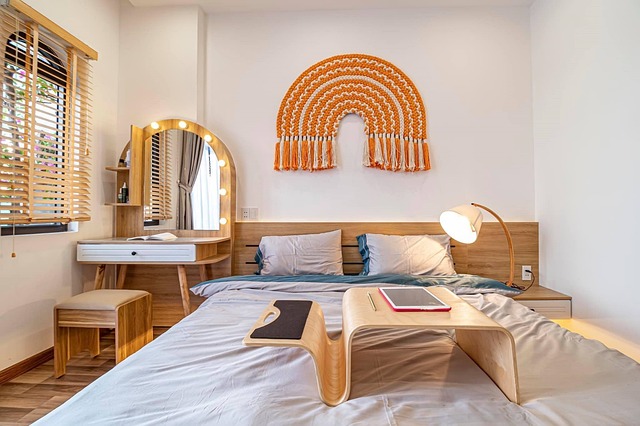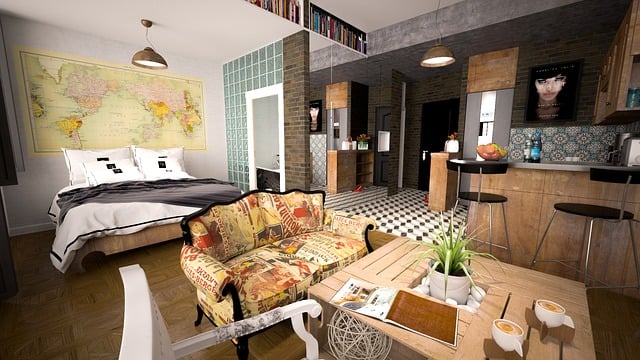 In the ever-evolving world of interior design, the Japandi style has emerged as a compelling trend. This fusion of Japanese and Scandinavian design principles combines the best of both worlds, offering a unique blend of simplicity, functionality, and natural beauty.
In the ever-evolving world of interior design, the Japandi style has emerged as a compelling trend. This fusion of Japanese and Scandinavian design principles combines the best of both worlds, offering a unique blend of simplicity, functionality, and natural beauty.
Japandi style captures the minimalist elegance of Japanese aesthetics and the cozy functionality of Scandinavian design, creating serene and practical spaces.
This article will delve into the origins, key characteristics, and practical applications of the Japandi style to help you transform your home into a harmonious retreat.
Origins and Philosophy of Japandi Style
Japanese Influence
The Japanese influence in the Japandi style is deeply rooted in the principles of minimalism and the appreciation of natural materials. Central to this is the concept of wabi-sabi, which celebrates the beauty of imperfection and the transient nature of life. This philosophy manifests in organic shapes, natural textures, and a restrained color palette, creating tranquil and balanced spaces.
Scandinavian Influence
Scandinavian design, known for its functionality and simplicity, perfectly complements the Japanese aesthetic. The Scandinavian concept of hygge, which emphasizes comfort and coziness, is integral to the Japandi style. Scandinavian design favors clean lines, practical furniture, and the use of light to create inviting and comfortable living spaces.
Fusion of Styles
Japandi style is the harmonious blending of these two design philosophies. It combines the Japanese focus on craftsmanship and natural beauty with the Scandinavian emphasis on functionality and comfort, resulting in an aesthetically pleasing and highly livable design style.
Critical Characteristics of Japandi Style
Minimalism
Minimalism is at the heart of Japandi style. Spaces are uncluttered and purposeful, with each item serving a specific function. This minimalist approach helps create a sense of calm and order, making rooms feel spacious and airy.
Natural Materials
Natural materials are a staple of Japandi decor. Wood, bamboo, stone, and natural fabrics like linen and cotton are commonly used. These materials add warmth and texture to the space, enhancing the connection to nature.
Neutral Color Palette
The Japandi style favors a neutral color palette dominated by whites, grays, and earthy tones. These muted colors create a serene and cohesive look, allowing the natural materials and textures to stand out.
Functional Design
Functionality is a crucial aspect of Japandi design. Furniture is often multi-functional and designed with practicality in mind. Storage solutions are cleverly integrated to keep spaces tidy and organized.
Craftsmanship
The Japandi style strongly appreciates craftsmanship. Handmade and artisanal pieces are valued for their uniqueness and quality, adding character and authenticity to the decor.
Designing a Japandi Living Room
Furniture
In a Japandi living room, opt for low-profile sofas, wooden coffee tables, and simple shelving units. Choose pieces that are both functional and aesthetically pleasing. A minimalist entertainment unit and functional storage solutions can help maintain a clean and uncluttered look.
Color Scheme
Stick to neutral tones with occasional pops of muted colors. A palette of soft grays, warm beiges, and natural wood tones will create a calming atmosphere. Add interest with textured cushions and throws in complementary colors.
Decor
Keep decor minimal and focus on natural elements. Use plants to bring life and greenery into the space. Simple ceramics, handmade vases, and woven textiles can add subtle decorative touches without overwhelming the room.
Lighting
Natural light is essential in Japandi design. Maximize natural light with sheer curtains and strategically placed mirrors. Choose simple, functional fixtures for artificial lighting that blend seamlessly with the decor.
Creating a Japandi Style Bedroom
Furniture
A Japandi-style bedroom should be a sanctuary of calm and relaxation. Choose a platform bed with clean lines, wooden nightstands, and minimal storage solutions. Avoid bulky furniture and keep the layout simple and uncluttered.
Textiles
Soft, natural fabrics like linen and cotton are perfect for bedding and curtains. Opt for neutral colors and simple patterns to maintain the minimalist aesthetic. Layering different textures can add warmth and coziness to the room.
Decor
Keep decor to a minimum and focus on creating a serene atmosphere. A few well-chosen items, such as a simple piece of wall art or a handmade ceramic vase, can add a touch of personality without cluttering the space.
Color Scheme
Use soothing, neutral colors to create a peaceful environment. Shades of white, beige, and gray are ideal for a Japandi bedroom. Add warmth with wooden accents and natural textures.
Japandi Kitchen and Dining Area
Furniture
Choose sleek, functional dining tables and chairs in the kitchen and dining area, often in natural wood. Open shelving can replace traditional cabinetry to maintain a clean, open look, and integrated storage solutions will help keep the space tidy.
Storage
Open shelving and minimal cabinetry are vital to maintaining the Japandi aesthetic. Use natural materials like wood and bamboo for storage containers and utensils. Keep countertops clear and clutter-free.
Materials
Natural stone countertops, wooden utensils, and ceramic dishware are perfect for a Japandi kitchen. These materials add texture and warmth to the space, enhancing the natural beauty.
Decor
Keep decor simple and functional. A few potted plants, a wooden fruit bowl, and handmade ceramics can add character without overwhelming the space. Choose decor items that are both beautiful and practical.
Japandi Bathroom Design
Fixtures
Minimalist fixtures with clean lines and natural materials are ideal for a Japandi bathroom. Choose simple, functional designs that blend seamlessly with the overall decor. Consider a wooden bath mat or bamboo accessories to add a touch of nature.
Color Scheme
Stick to neutral and calming tones, often with a spa-like feel. Shades of white, beige, and gray create a serene atmosphere. Add warmth with wooden accents and natural textures.
Storage
Hidden storage solutions can help keep surfaces clutter-free. Consider built-in shelves, under-sink storage, and wall-mounted cabinets to maintain a clean and tidy look.
Accessories
Natural elements like wooden bath mats, stone soap dishes, and plants can add a touch of nature to the bathroom. Keep accessories minimal and functional to maintain the Japandi aesthetic.
Integrating Japandi Style in Other Areas
Home Office
Create a functional, uncluttered workspace with natural light and simple decor. Choose a minimalist desk, ergonomic chair, and clever storage solutions. Keep the color palette neutral and add a few plants for a touch of greenery.
Outdoor Spaces
Use natural materials and minimalist design for a seamless indoor-outdoor flow. Wooden decking, simple outdoor furniture, and potted plants can create a serene outdoor retreat. Consider a Zen garden or water feature for added tranquility.
Entryway
A simple, functional entryway with storage solutions and natural decor elements can set the tone for the rest of the home. Choose a minimalist bench, wall hooks, and shoe rack to keep the space organized and clutter-free.
DIY Japandi Decor Projects
Furniture Upcycling
Refurbishing old furniture with a minimalist touch can add a personal touch to your decor. Sand down and repaint old wooden pieces, or add new hardware for a fresh look. Consider converting an old dresser into a functional storage unit.
Craft Projects
Creating your ceramics, textiles, or wooden decor pieces can add a personal touch to your home. Look for online tutorials and workshops to learn new skills and create unique items.
Step-by-Step Guides
Many online resources provide step-by-step instructions for DIY Japandi decor projects. Whether you’re making a simple wooden shelf or sewing cushion covers, these projects can be both fun and rewarding.
Shopping Tips and Resources
Where to Shop
Many stores and online shops specialize in the Japandi style. Look for retailers that offer minimalist, natural, and functional items. Some popular options include IKEA, Muji, and local artisanal shops.
What to Look For
When shopping for Japandi decor, look for quality, minimalist, and natural pieces. Choose items that are both beautiful and functional and that fit within the neutral color palette.
Budget-Friendly Options
Achieving the Japandi look doesn’t have to be expensive. Thrift stores, second-hand furniture shops, and DIY projects can help you create a beautiful space on a budget. Look for sales, discounts, and online marketplaces for affordable options.
Sustainable and Eco-Friendly Japandi Decor
Sustainability Principles
Japandi is a style that promotes eco-friendly living by emphasizing natural materials, minimalism, and quality craftsmanship. By choosing sustainable decor, you can reduce waste and create a healthier home environment.
Eco-Friendly Materials
Look for sustainable materials such as reclaimed wood, organic fabrics, and non-toxic finishes. These materials are better for the environment and can add natural beauty to your home.
Upcycling and Repurposing
Upcycling and repurposing items can be a great way to achieve the Japandi look while being eco-friendly. Consider refurbishing old furniture, reusing materials, and creating new items from existing pieces.
Conclusion
Japandi style offers a timeless and harmonious approach to home decor, blending the best of Japanese and Scandinavian design. By focusing on minimalism, natural materials, and functional design, you can create a serene and practical living space. Whether you’re designing a Japandi living room, bedroom, kitchen, or bathroom, the key is to keep things simple, natural, and purposeful. Embrace the beauty of this fusion style and transform your home into a tranquil retreat.


